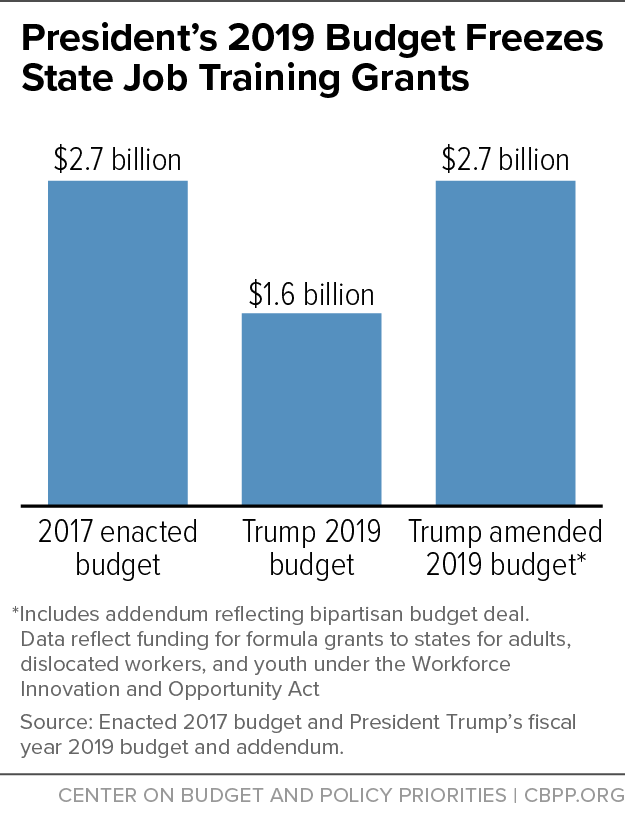BEYOND THE NUMBERS
The House Higher Education and Workforce Development Subcommittee this morning discussed the supposed merits of implementing and expanding work requirements in basic assistance programs, with some lawmakers claiming they would help jobless workers land a job and achieve financial independence. But taking away the food assistance and health care that make it easier for people to find and keep a job is counterproductive, especially when policymakers also don’t provide adequate job support services for people to meet work requirements. Similarly, as we note in our new report, President Trump’s 2019 budget claims to help struggling workers, but it cuts a range of programs supporting work and economic opportunity.
The President’s budget fails to reinvest in core job training programs, sets these programs up for likely deep cuts in future years, and proposes cuts in a range of other programs that support work and opportunity. While it proposes a modest rise in apprenticeship program funding, even that’s at risk under the budget’s future cuts to overall non-defense discretionary (NDD) funding — and that modest rise would also fall well short of offsetting the cuts to other programs. Overall, the budget would:
- Freeze state job training grants. The President’s 2019 initial budget — the budget that went to print before the Administration and Congress reached a budget agreement in February for 2018 and 2019 — would have cut state job training grants under the Workforce Innovation and Opportunity Act (WIOA) by 40 percent (see chart). Even after the President proposed a budget “addendum” that accounted for the budget agreement’s additional funding, the President proposed freezing the grants at their 2017 level of $2.7 billion, meaning they would be worth less in 2019 due to inflation.
Job training funding has been falling for several years, in large part due to the tight caps that the 2011 Budget Control Act, which were further reduced by sequestration, placed on NDD programs. Under the President’s post-addendum budget, funding for WIOA job training grants in 2019 would be 22 percent less than its 2010 level, after adjusting for inflation. And funding for job training would likely fall substantially in years after 2019 because the President’s budget calls for sharp cuts in NDD funding after 2019.
- Cut or eliminate several job training programs. The President’s budget also cuts Job Corps by a quarter and cuts another $531.9 million from job training by eliminating three programs that target groups facing unique barriers to work: the Indian and Native American national programs, the Senior Community Service Employment program, and the Migrant and Seasonal Farm Worker program. (The President would direct the Secretary of Labor to set aside 1.5 percent of WIOA adult formula funds to support Indian and Native American programs.) To be sure, there might be reasons to reduce funding in some areas to invest more in others. But the proposed cuts in training programs overall show that investing in skills is not a priority for the President.
The budget mentions that the Labor and Education secretaries are developing a plan to “consolidate and reorganize Federal workforce development programs” that it says will be released in the spring of 2018, but it provides no other details. “Consolidate” and “efficiency” are terms that some policymakers have used to justify program cuts. There may be reasons to consolidate or reorganize some programs, but a key question will be whether those changes — along with the accompanying budget proposals — will mean those in need will have more or less access to high-quality job training opportunities and whether those opportunities will be sufficient to address the needs of workers and employers.
- Include some modest new investments in 2019, which could be in jeopardy because of NDD cuts after 2019. The budget proposes to increase funding for apprenticeship programs to $200 million in 2019, up from $95 million in 2017. Apprenticeship programs are important and policymakers should expand them, but they’re just one part of a workforce development strategy (just 6 percent of the Labor Department’s training and employment services budget in the President’s proposal).
The Administration claims that it’s trying to aid those left behind in today’s economy and help more people work. But the President’s budget would also make college more expensive, underinvest in child care, target working families for cuts in assistance that help them afford the basics, and, in some cases, even reduce work incentives in existing program eligibility rules. Taken together, these proposals will make it significantly harder for people left behind to move up the economic ladder.

